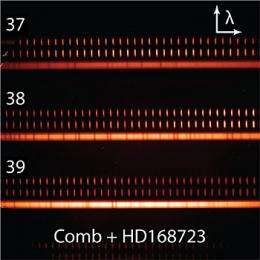'Star Comb' joins quest for Earthlike planets

(�鶹��ԺOrg.com) -- If there is life on other planets, a laser frequency comb developed at the National Institute of Standards and Technology (NIST) may help find it.
Such a comb—a tool for precisely measuring frequencies, or colors, of light—has for the first time been used to calibrate measurements of starlight from stars other than the Sun. The good results suggest combs will eventually fulfill their potential to boost the search for Earth-like planets to a new level.
As described in Optics Express, the comb was transported to the Texas mountains to calibrate a light analyzing instrument called a spectrograph at the Hobby-Eberly telescope. A University of Colorado Boulder (CU) astronomer and Pennsylvania State University students and astronomers collaborated on the project.
“The comb worked great,” says NIST physicist Scott Diddams. “In a few days, it enabled measurement precision comparable to the very best achieved in the same wavelength range with much more established techniques—and we hope the comb will do much better as the new technique is perfected.”
The NIST comb calibrated measurements of infrared starlight. This type of light is predominantly emitted by M dwarf stars, which are plentiful in Earth’s part of the galaxy and might have orbiting planets suitable to life.
To search for planets orbiting distant stars, astronomers look for periodic variations in the apparent colors of starlight over time. A star’s nuclear furnace emits white light, which is modified by elements in the star’s and the Earth’s atmosphere that absorb certain narrow bands of color. Periodic changes in this characteristic “fingerprint” can be caused by the star wobbling from the gravitational pull of an orbiting planet. More than 600 planets have been discovered using star wobble analysis, but a planet analogous to the Earth, with low mass and orbiting at just the right distance from a star—in the so-called “Goldilocks zone”—is hard to detect with conventional technology.
The wobbling effect is very subtle. Astronomers are limited by the precision of techniques used to measure the starlight, and infrared frequencies in particular can be challenging to measure precisely with conventional tools. But the NIST comb, which spans an infrared wavelength range of 1450—1700 nanometers, provides strong signals at narrowly defined target frequencies and is traceable to international measurement standards. Used with a spectrograph, the frequency comb can act like a very precise ruler to calibrate and track the exact colors in the star’s fingerprint and detect any periodic variations.
The NIST comb measured radial velocity—star wobble—with a precision of about 10 meters per second, comparable to the best ever achieved in the infrared region of the electromagnetic spectrum. The first field results are limited by the short observation time and technical issues associated with the newly developed experimental approach. The team hopes to soon improve precision to 1 meter per second, roughly the limit to date for measuring visible light from the Sun—which would put the technique at the cutting edge of infrared astronomy. The NIST comb has the inherent capability to measure star wobble of just a few centimeters per second, 100 times better, although limitations in the spectrograph and in the stability of the star itself may constrain the ultimate precision.
CU graduate student Gabe Ycas, along with Diddams and CU astronomer Steve Osterman, created the frequency comb, which has widely spaced “teeth,” or calibration points, tailored to the reading capability of spectrographs. This work was supported by NIST and the National Science Foundation. Penn State is a partner in the telescope and spectrograph.
More information: G.G. Ycas , et al. Demonstration of on-sky calibration of astronomical spectra using a 25 GHz near-IR laser frequency comb. Optics Express, Vol. 20, No. 6. Published March 6 , 2012.
Journal information: Optics Express
Provided by National Institute of Standards and Technology

















